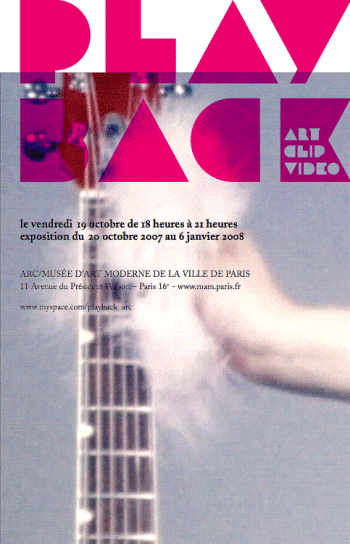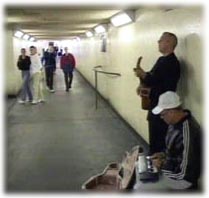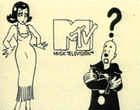Aidan Curran posted on December 30, 2007 11:26
 ‘Playback’ is an exhibition running at the Musée d'Art Moderne in Paris until 6 January. In the words of the show's programme, the show "investigates the incursion of visual artists into the field of sound, in the form of original music videos." In other words, it brings together promo clips made by visual artists more at home with modern art than contemporary music.
‘Playback’ is an exhibition running at the Musée d'Art Moderne in Paris until 6 January. In the words of the show's programme, the show "investigates the incursion of visual artists into the field of sound, in the form of original music videos." In other words, it brings together promo clips made by visual artists more at home with modern art than contemporary music.
Unfortunately, the exhibition's premise is flawed. Essays in the brochure and catalogue repeatedly put 'high art' in conflict with 'pop culture', assuming as a truism that art is art, pop is pop, the two are irreconcilable and the artists featured in the show are transgressing some natural law of aesthetics.
This, as we all know, is outdated snobbishness - Andy Warhol's appearance in one of the featured videos, 'Hello Again' by The Cars, reminds us of the man who brought pop into art and art into pop. And three of Derek Jarman's iconic Smiths' videos ('The Queen Is Dead', 'There Is A Light That Never Goes Out' and 'Panic') are screened, the late British film-maker just being one of many artists whose genuine engagement with the music video form subverts the patronising premise of this exhibition.
One of the other problems with the exhibition is the lack of any focus or criteria for selecting the videos. The show is presented in various installations around the exhibition space, grouped under headings such as Dance, Posture, Karaoke, Bootleg and Seen On TV. Yet there's no indication as to why the featured videos were selected, what their specific qualities are, or how or if they challenge/comment on the music video form. The Dance section, presented on the small screens of real gym running-machines, features cheap shot-on-video clips of unremarkable dancing to flat music, with no hint of irony, subversion, interesting concept, technical innovation or even just playing for laughs. Like much of the exhibition, it fails as both music video and modern art.
The overall impression is that the curators of ‘Playback' are passing off a half-baked, reactionary, clichéd 'post-modern' concept of music video culture (with all its supposed superficial pop glamour that pretentious art self-righteously looks down on) as aesthetic critique.
 The artists themselves often fare no better in getting a handle on the music video form. In 2002 the Pet Shop Boys engaged the services of two respected visual artists, Wolfgang Tillmans and Martin Parr, to shoot videos for the songs ‘Home And Dry’ and ‘London’ respectively. The similarities between both videos, included in the exhibition, are striking – both are shot on cheap video, feature the litter-strewn streets and underground of everyday London (no surprise to fans of Parr’s fascinating photography) and star Neil Tennant and Chris Lowe (left) in casualwear and playing simple instruments (in both videos Tennant, looking like Ray D’Arcy, strums 4/4 time on an acoustic guitar like a plain-clothes priest leading a folk mass).
The artists themselves often fare no better in getting a handle on the music video form. In 2002 the Pet Shop Boys engaged the services of two respected visual artists, Wolfgang Tillmans and Martin Parr, to shoot videos for the songs ‘Home And Dry’ and ‘London’ respectively. The similarities between both videos, included in the exhibition, are striking – both are shot on cheap video, feature the litter-strewn streets and underground of everyday London (no surprise to fans of Parr’s fascinating photography) and star Neil Tennant and Chris Lowe (left) in casualwear and playing simple instruments (in both videos Tennant, looking like Ray D’Arcy, strums 4/4 time on an acoustic guitar like a plain-clothes priest leading a folk mass).
And Parr’s video for ‘London’ is sunk because of amateurish acting by two men supposed to be playing down-on-their-luck Russian immigrants (as in the song) but grinning giddily in each shot. At least Tillmans fares better; his footage of mice scurrying through the litter on Tube tracks makes a nice counterpoint to ‘Home And Dry’ - a sweet, heartfelt song about missing someone who’s away on work.
Other things we learned from the exhibition: Everything about Blur’s ‘Country House’ – song, style, Damien Hirst’s video – has aged horribly. Modern artists like to listen to Sonic Youth and Laurie Anderson’s unbearable ‘O Superman’. And RTÉ’s ‘Charity You’re A Star’ is actually a work of post-modern art inspired by legendary German conceptual artist Joseph Beuys singing anti-Reagan song ‘Sonne Statt Reagan’ on a TV show in 1982. There’s something priceless about seeing one of modern art’s most celebrated figures merrily swinging a microphone above his head while singing tunelessly to German pub-rock.
 Some of the best works in the exhibition were old MTV station idents by Dara Birnbaum (right) and Miguel Calderon. They reminded us that truly innovative and artistically rich music videos come from people like Michel Gondry and Spike Jonze who clearly love the medium and bring an unsnobbish, pop-loving creative imagination to their work.
Some of the best works in the exhibition were old MTV station idents by Dara Birnbaum (right) and Miguel Calderon. They reminded us that truly innovative and artistically rich music videos come from people like Michel Gondry and Spike Jonze who clearly love the medium and bring an unsnobbish, pop-loving creative imagination to their work.
We learned nothing from this exhibition about the form, aesthetics or development of music videos, the cultural signs and artistic possibilities that make music video such a fascinating subject worthy of rigorous investigation. But perhaps, having learned loads at this summer’s fantastic ‘Rock N’Roll 39-59’ exhibition at the Fondation Cartier, we were expecting too much from ‘Playback’.
The lesson we took from ‘Playback’ was perhaps contrary to its intentions: glamorous, image-obsessed pop music is infinitely more subversive, shocking, imaginative and innovative than ponderous, self-conscious modern art. The best pop music (like all great art, in fact) makes you dream and aspire to transcend your humdrum world, and the best music videos capture these dreams on film. No wonder The Man got rid of Smash Hits and Top Of The Pops.
Here’s our favourite video from the exhibition: Miguel Calderon’s clip for ‘Deiciseis’ (Sixteen) by Los Super Elegantes. There’s something for everyone: music fans can appreciate the fine song, video-lovers will dig the funny, warm-hearted storyline (lowlife boy runs off with nice girl, while her mother disapproves), while modern art theorists can consider Calderon’s use of images of rubbish and riches. But be careful - you can’t dance and think at the same time:
More ...
[Read More...]